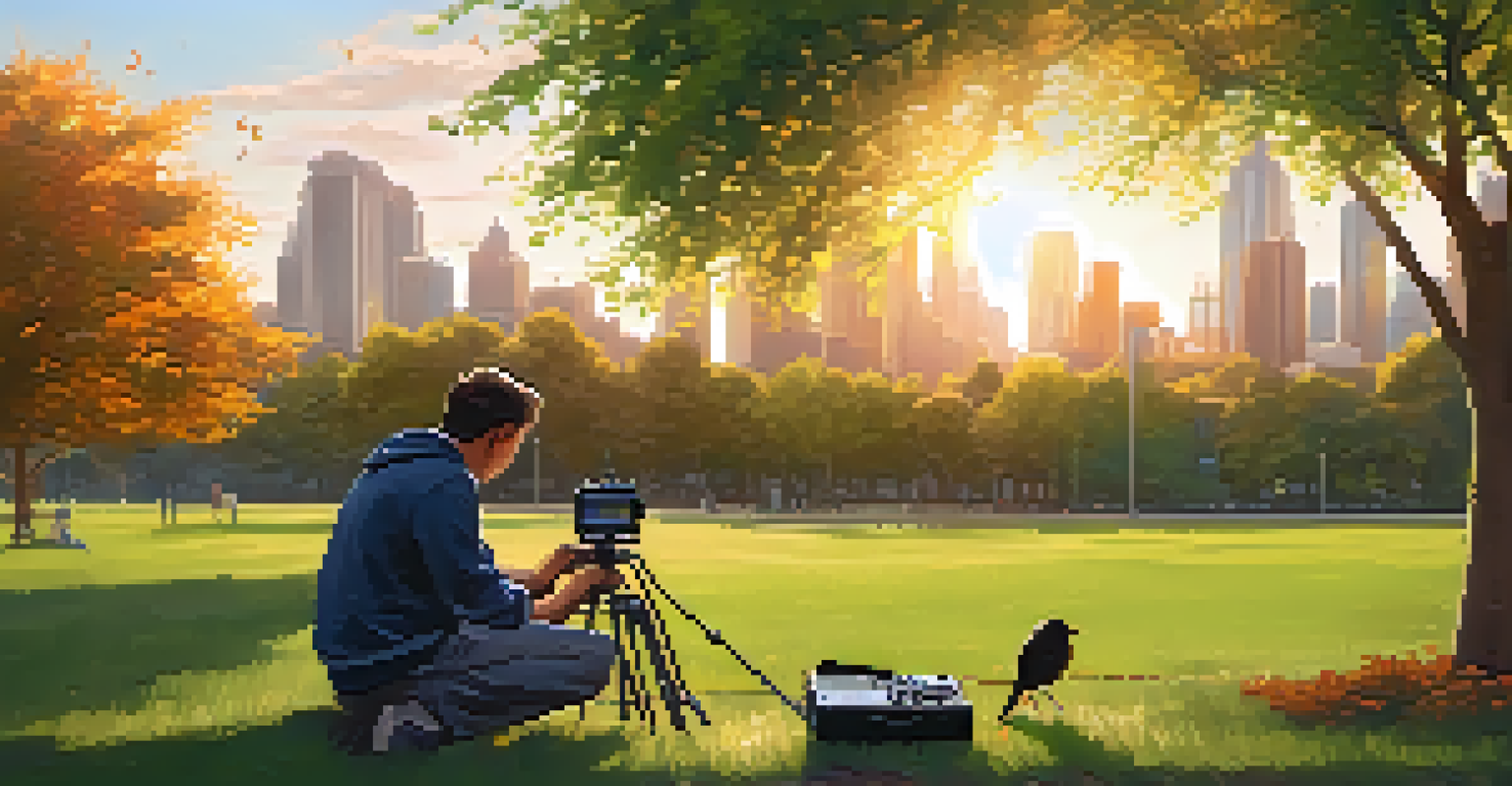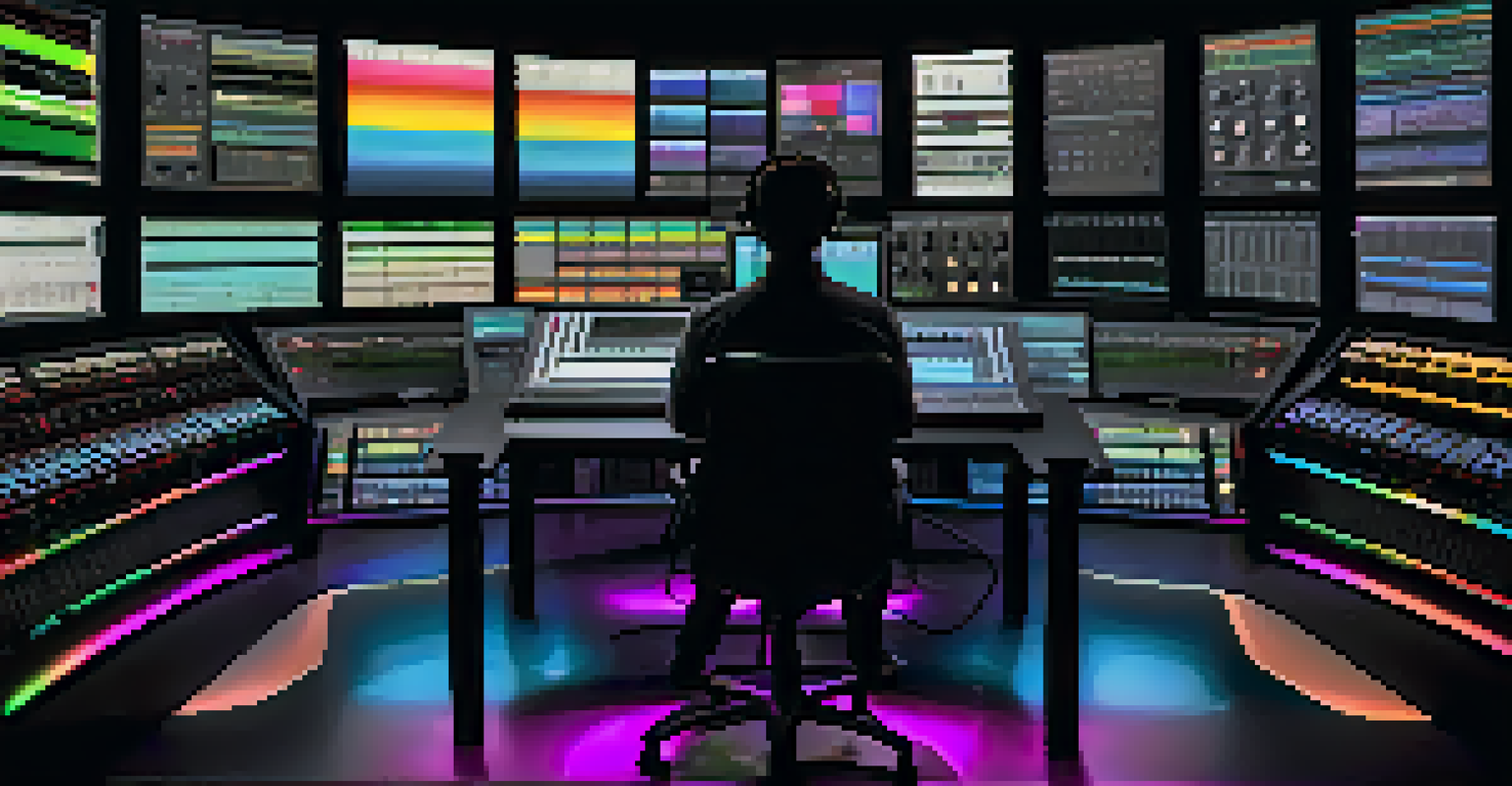The Role of Sound Designers in the Film Production Process

What Sound Designers Do in Film Production
Sound designers are the unsung heroes of film production, responsible for creating the auditory landscape that enhances the viewing experience. They work closely with directors and producers to ensure that the sounds align with the film's emotional tone and narrative. From creating sound effects to designing the overall audio environment, sound designers play a crucial role in storytelling.
Sound design is the invisible art that shapes the way we perceive film.
Their work begins in pre-production, where they collaborate on ideas and concepts for the sound design. They also scout locations to identify potential audio challenges and opportunities. By understanding the director's vision, sound designers lay the groundwork for a cohesive audio experience that complements the visuals.
During production, sound designers often capture location sounds, ensuring that the film's world feels authentic. They might record dialogue, ambient sounds, and other audio elements necessary for the project. This groundwork sets the stage for the detailed sound editing and mixing that follow.
The Importance of Sound Design in Storytelling
Sound design is pivotal in shaping the emotional journey of a film. It can evoke feelings of tension, joy, or sadness, guiding the audience's reactions and connections to the story. Just think about a horror movie; without those chilling sound effects, the suspense would be significantly diminished.

Consider the use of silence in sound design, which can be just as powerful as a loud explosion. A moment of silence can create tension and anticipation, making the eventual sound even more impactful. By carefully manipulating sound, designers can control the pacing and emotional weight of a scene.
Sound Design Enhances Storytelling
Sound designers create auditory landscapes that shape the emotional journey and engagement of the audience with the film.
Sound also helps to establish the film's setting and time period. Authentic sounds, whether it’s the bustle of a city or the chirping of crickets in a rural area, transport the audience into the film's world. This immersive experience is crucial for engaging viewers and keeping them invested in the story.
Collaboration with Other Departments
Sound designers don’t work in isolation; they collaborate with various departments to ensure a harmonious production. They often liaise with directors, cinematographers, and editors to align the auditory and visual elements of the film. This teamwork is vital for crafting a cohesive final product.
The sound is half the experience of watching a movie.
For instance, sound designers must understand the visual style of the film to create sounds that fit seamlessly with the imagery. They might discuss specific scenes with the cinematographer to capture the right ambiance. This collaborative spirit fosters creativity and innovation, leading to remarkable storytelling.
Moreover, sound designers work closely with the music department to integrate scores and soundtracks effectively. The interplay between dialogue, sound effects, and music can elevate a film, making it an unforgettable experience. This synergy is key to achieving the desired emotional impact.
The Tools of the Trade for Sound Designers
Sound designers use a variety of tools and technologies to create their auditory masterpieces. Digital audio workstations (DAWs) like Pro Tools and Logic Pro are essential for editing and mixing sound. These platforms allow sound designers to manipulate audio tracks and create intricate soundscapes.
In addition to software, sound designers often rely on an array of hardware, such as microphones, audio interfaces, and field recorders. High-quality recording equipment is crucial for capturing sound accurately, whether on location or in a studio setting. The right tools empower designers to deliver professional-grade audio.
Collaboration is Key in Production
Successful sound design relies on teamwork with various departments to ensure a seamless integration of audio and visuals.
Furthermore, sound libraries, which are collections of pre-recorded sounds, serve as valuable resources. These libraries save time and provide inspiration, allowing designers to find the perfect sound for a scene. Overall, the combination of creativity and technology defines the craft of sound design.
The Sound Editing Process Explained
Once filming is complete, sound designers dive into the sound editing process, which involves refining and organizing all recorded audio. This stage includes syncing dialogue with visuals, cleaning up unwanted noise, and layering sound effects. The goal is to create a polished audio track that enhances the film’s narrative.
Sound designers meticulously edit each audio element to ensure clarity and coherence. They may add ambient sounds, Foley effects (which are sounds created in post-production to enhance realism), and any additional audio needed to fill out the soundscape. This attention to detail is what elevates a film from good to great.
After the initial editing, the sound is mixed, which involves balancing levels, adjusting frequencies, and adding effects. Mixing is a crucial step where sound designers ensure that dialogue is clear, music complements the scene, and effects immerse the audience. This intricate process is what ultimately brings the film to life audibly.
The Art of Mixing Sound for Film
Mixing is where the magic happens, as sound designers blend all audio elements into a cohesive final track. This stage requires a keen ear and a deep understanding of how sounds interact. The right mix can amplify the emotional weight of a scene, making it resonate with the audience.
During mixing, sound designers adjust the volume levels of dialogue, music, and effects to ensure balance. They might emphasize certain sounds to draw attention or create depth within a scene. The goal is to create a dynamic audio experience that enhances the visual storytelling.
Mastering Finalizes Audio Quality
The mastering process polishes the audio for distribution, ensuring clarity and consistency across all playback platforms.
Additionally, sound designers use various effects like reverb, delay, and equalization to shape the sound. These effects add richness and dimension, making the audio feel more immersive. A well-mixed film captivates the audience, drawing them into the story and keeping them engaged.
The Final Touch: Mastering Sound for Distribution
Once mixing is complete, the final step in the sound design process is mastering. This involves preparing the audio for distribution, ensuring it meets industry standards and sounds great on all playback systems. Mastering is like polishing a gemstone; it enhances the final product to make it shine.
During mastering, sound designers make final adjustments to the overall sound, ensuring clarity and consistency across different formats. They check for any technical issues and optimize the audio for various platforms, whether it’s a theater, television, or streaming service. This attention to detail ensures that audiences enjoy the best possible sound experience.

Ultimately, mastering is about delivering a professional and polished audio track that complements the film’s visual elements. It’s the final touch that brings everything together, making the film ready for its audience. Sound designers play a crucial role in this process, ensuring that their artistic vision is fully realized in the final product.